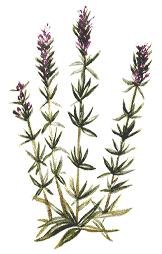Latin Name
Hyssopus officinalis

General Description
After centuries of use in Europe, hyssop was such a popular remedy for coughs and other
respiratory ills that European colonists brought it to North America. A shrub with
white, pink or blue flowers, hyssop is part of the mint family. It is used as an
expectorant, digestive aid, sedative,and muscle relaxant. Volatile oils in the leaves
and flowers, bitter tasting and with a strong camphorlike odor, help loosen mucus and
stimulate coughing and decrease gas. Hyssop is also used as an antiseptic; its oils may
heal wounds and herpes simplex sores.
Target Ailments
Taken internally for:
Applied externally for:
Preparations
Over the counter:
Available dried or fresh and as tincture.
At home:
Tea: 2 tsp. dried herb per cup of boiling water steeped for 10 to 15 minutes. Drink
three times a day for cough (honey, sugar or lemon added to improve the flavor); gargled
three times a day for sore throat. Applied to burns and wounds.
Compress: 1 oz. dried herb steeped in 1 pint of boiling water for 15 minutes; clean
cloth soaked in solution and applied warm to cold sores or genital herpes sores; placed on the
chest to relieve congestion.
Combinations: Used with white horehound and coltsfoot for coughs and bronchitis;
with boneset, elder flower and peppermint for cold symptoms; and with sage as a gargle
for sore throats.
Special Information